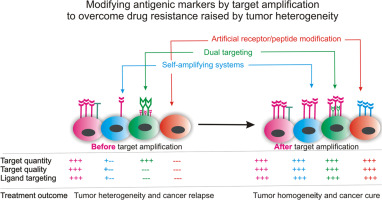Journal of Controlled Release ( IF 10.8 ) Pub Date : 2018-02-16 , DOI: 10.1016/j.jconrel.2018.02.020 Khaled Seidi , Heidi A. Neubauer , Richard Moriggl , Rana Jahanban-Esfahlan , Tahereh Javaheri

|
Tumor cells overexpress surface markers which are absent from normal cells. These tumor-restricted antigenic signatures are a fundamental basis for distinguishing on-target from off-target cells for ligand-directed targeting of cancer cells. Unfortunately, tumor heterogeneity impedes the establishment of a solid expression pattern for a given target marker, leading to drastic changes in quality (availability) and quantity (number) of the target. Consequently, a subset of cancer cells remains untargeted during the course of treatment, which subsequently promotes drug-resistance and cancer relapse. Since target inefficiency is only problematic for cancer treatment and not for treatment of other pathological conditions such as viral/bacterial infections, target amplification or the generation of novel targets is key to providing eligible antigenic markers for effective targeted therapy. This review summarizes the limitations of current ligand-directed targeting strategies and provides a comprehensive overview of tumor target amplification strategies, including self-amplifying systems, dual targeting, artificial markers and peptide modification. We also discuss the therapeutic and diagnostic potential of these approaches, the underlying mechanism(s) and established methodologies, mostly in the context of different nanodelivery systems, to facilitate more effective ligand-directed cancer cell monitoring and targeting.
中文翻译:

肿瘤靶点扩增:对纳米药物递送系统的影响
肿瘤细胞过度表达正常细胞所缺乏的表面标志物。这些肿瘤限制性抗原标记是区分靶标细胞与靶标细胞以进行配体定向靶向癌细胞的基本基础。不幸的是,肿瘤异质性阻碍了给定靶标标记物的固体表达模式的建立,导致靶标的质量(可用性)和数量(数量)的急剧变化。因此,在治疗过程中,一部分癌细胞仍未被靶向,这随后促进了耐药性和癌症复发。由于靶标无效性仅对癌症治疗有问题,而对其他病理性疾病(如病毒/细菌感染)的治疗无问题,靶标扩增或新靶标的产生是为有效的靶向治疗提供合格的抗原标记的关键。这篇综述总结了当前针对配体的靶向策略的局限性,并提供了肿瘤靶扩增策略的全面概述,包括自我扩增系统,双重靶向,人工标记和肽修饰。我们还将讨论这些方法的治疗和诊断潜力,主要的机制和已建立的方法,主要是在不同的纳米递送系统的背景下,以促进更有效的配体定向癌细胞监测和靶向。这篇综述总结了当前针对配体的靶向策略的局限性,并提供了肿瘤靶扩增策略的全面概述,包括自我扩增系统,双重靶向,人工标记和肽修饰。我们还将讨论这些方法的治疗和诊断潜力,主要的机制和已建立的方法,主要是在不同的纳米递送系统的背景下,以促进更有效的配体定向癌细胞监测和靶向。这篇综述总结了当前针对配体的靶向策略的局限性,并提供了肿瘤靶扩增策略的全面概述,包括自我扩增系统,双重靶向,人工标记和肽修饰。我们还将讨论这些方法的治疗和诊断潜力,主要的机制和已建立的方法,主要是在不同的纳米递送系统的背景下,以促进更有效的配体定向癌细胞监测和靶向。


























 京公网安备 11010802027423号
京公网安备 11010802027423号